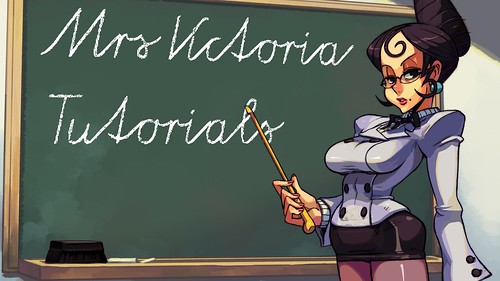This is Mrs. Victoria.

She’s a teacher at Filia’s school, and will be your guide through the tutorials I’m creating for *Skullgirls*.
Creating new fighting game fans is an important goal for us at Reverge Labs. Not only do we need to make sure players pick up *Skullgirls*, but then we also need to make them fall hopelessly in love with it and stick around for the long term. We need this mostly so everyone has a wide variety of players to fight against online once the game comes out. But it’s a tough problem – fighting games are really complicated, and sacrificing any level of gameplay depth to appeal to new players is strictly off the table. Lowering the skill cap is certainly an easy way to get people to it faster, but they’ll inevitably become bored with shallow gameplay and leave. Instead, we want to help players get to the heart of the game faster. Teaching people to play is an area that fighting games have traditionally done very poorly in. Some games attempt to ease the introduction to the world of fighting games by including beginner modes with simplified controls. The problem is this creates a real disconnect between the player’s controls and the actions they see on screen – while they can press buttons to make rainbows and get in faster, it tends to make things more confusing in the long run. It also forces the player to unlearn almost everything they’ve learned if they ever want to start playing without assistance turned on.
Some fighting games have made strides in bringing new players into the fold, however. *BlazBlue: Continuum Shift* has tutorial that goes in depth enough to get to topics like 50/50 setups, and *Street Fighter 3: 3rd Strike Online*’s parry tutorials are a great way to interactively teach new players one of the harder parts of the game. We want to take this to the next level in *Skullgirls* by including an expansive set of tutorials aimed at teaching players the fundamentals of the game. We want to teach people not only the basic controls, but also help them approach the game from the right perspective.
When teaching new players their first fighting game, it’s tempting to first teach them how to perform special moves, and start doing combos. And those are important concepts to be sure, and certainly ground we’ll cover in our tutorials. But it’s at least as important to teach people how to defend themselves, and how not just to do attacks, but put together an attack plan. With that in mind, we plan to include tutorials in fundamentals like poking, hit confirmation, and high/low mix-ups.
For the various elements of the game, we start with defense, not only teaching you guard against various types of attacks, but also how people will try and get around those protections. Then we teach you how to employ those techniques yourself. We think this approach will give people a better foundation. Not only will people learn how to perform techniques, but also when they should and why.
Tutorials in games have a habit of being kind of boring and tedious, but we’re doing our best to keep *Skullgirls*’ tutorial engaging at all times. The tutorials are designed to keep text at an absolute minimum, so we can follow the old adage about showing and not telling. We’re also trying to keep the learning as interactive as possible. As an example, I’m working on a tutorial now about punishing unsafe attacks. The obvious way to implement this would be to have a computer opponent perform unsafe attack strings, and ask the opponent to follow up with a counter attack. And we do that. But in the next challenge, the opponent attacks you with both safe and unsafe strings, and asks the player to punish only the unsafe strings. This way, we not only teach you about safe vs. unsafe, but also make you apply that knowledge in a (more) realistic situation so that knowledge really sticks.
Brief aside: The point at which fighting games moved from fun to a full blown obsession for me was when I read James Chen’s *X-Men vs. Street Fighter* FAQ. Before that moment, air combos were just this thing that the computer occasionally hit me with that I never really understood. After that moment, I spent every spare moment I had in training mode, trying to find new ways to string sequences of moves together and perfecting my execution. Tutorials are usually one of the things developers generally dread making, but I hope you can now understand how genuinely excited I am to be working on a tutorial for our fighting game.
Combos in *Skullgirls* are very fluid, and almost a means of creative expression at times. But to experience the joy of creating new combos, you need to understand the tools you have available to you. I hope that running through the combo system tutorial will spark the imagination of others the way mine was when I first learned I could delay Cyclops’ Gene Splice to get a relaunch or use Ryu’s Up + HK to do flying screen shenanigans in the corner.
Creating the tutorial system has by far been the part of *Skullgirls* I’ve been most excited to work on. All too often I’ve talked to people who like fighting games but feel intimidated by them: they see a future of being ground down by loss after loss and spending hours in training mode learning execution. And I don’t think any tutorial will eliminate that, but I do hold a lot of hope that we can give them a head start and some direction by shining a spotlight on the heart of fighting games, and really showing people why they’re so much fun in the first place.

